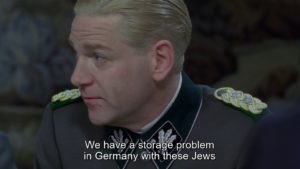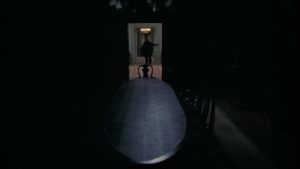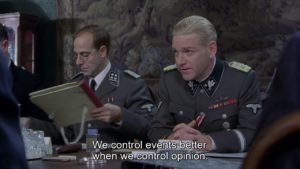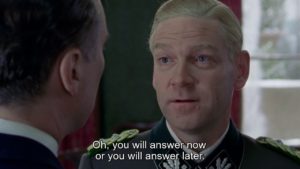Wansee Conference – Two Movies – CHILLING
Almost everyone knows what happened in The Holocaust – the systematic extermination of Undesirables and “Untermenschen”. These included anyone who opposed the Nazi philosophy and ideology, targeted groups like Jews, Gypsies, Communists, Homosexuals, Mentally unwell people, and opponents of the regime – in short, anyone and everyone the Nazis thought didn’t fit or opposed the Nazi ideology. In a Police State, it was easy to “catch” such “undesirables”, but what to do with them?

The Wannsee Conference was the result — a place away from the capital Berlin by the side of the Wannsee Lake.

During my visits to Berlin in 2012, 2016 and 2019, I was chilled to see S-Bahn trains with the last stop as “Wannsee”. Today, Wannsee is just a place where Berliners go to do some weekend swimming in summer or sit by the lake and its environs. In January 1942, it was the site of a conference chaired by the cold calculating Reinhard Heydrich, who got together various ministers, explained the problem and told them to arrive at a solution. Only one copy of the meeting minutes survived, and the films are based on that.

If you have ever attended an inter-departmental meeting, irrespective of the nature of your work, you know that there will be at least one or two persons who will argue that “I can’t get those results within the resources given to me”. When Heydrich sets out the objective of The Final Solution – systematically eliminating all such undesirables – most ministers take the approach that, given their current resources, they cannot carry out the tasks or – more chilling – the rules and the law have some ambiguities. Soon arguments and threats break out between ministers, each insisting on a valid reason as to why they can’t take on such capacity or whether the laws are adequate or not.

Everyone raises objections as it’s a balance between transporting the undesirables or “eliminating them in site” while dealing with the constant demands for quick movement of men and material to the Eastern Front that was swallowing up all Nazi resources.
Hannah Arendt reporting on the 1961 Eichmann trial, mentioned that “evil can be banal” – meaning ordinary and colourless. Eichmann was just a colourless bureaucrat who only carried out the orders – efficiently and systematically. (More on the banality of evil in these links
https://www.theguardian.com/commentisfree/2011/aug/29/hannah-arendt-adolf-eichmann-banality-of-evil
https://philosophybreak.com/articles/hannah-arendt-on-standing-up-to-the-banality-of-evil/
The ministers who make up the Conference are only doing their jobs, and there is nothing to mark them otherwise — just another day at the office transporting undesirables with the cooperation of other ministries.
Conference ( 2001) is simply bone-chilling and how normal it was for a cultured nation leading the world in science, arts and philosophy to descend into depravity and pure evil. The film shows that none of the ministers is raising ANY moral objections – it is only a task to be carried out efficiently within the resources available or by pouring more resources into the job.


Given the kind of worldwide shift to the far right, perhaps this film is more than worth its weight and should be required viewing to get in touch with our humanity.

It shows how ordinary evil has become, and since the Nazis don’t necessarily believe themselves to be evil – only racially pure – their actions are just taken as problem-solving! That’s what they believe, and this is what the film shows in chilling detail.
Don’t expect any action. There is talk – LOTS of conversations. But it is the talk that is chilling and hair-raising! Kenneth Branagh doesn’t look like Reinhard Heydrich, but he projects Heydrich – cold, calculating, the consummate bureaucratic head playing off one minister against the other, and wanting a consensus, no matter what.

Stanley Tucci as Adolf Eichmann is equally chilling – the organiser who sees to it that pads are neat, the pencils are sharp, the food is good and the wine is supreme! Parts of the film were shot at the actual Wannsee Conference Museum at Wannsee and mixed in with studio sets.
Conspiracy is available on Netflix and Amazon Prime worldwide but not in India!! However, there is a link but with lots of popups and ads.
https://bingewatch.to/watch-movie/watch-conspiracy-hd-11527/1067739
There is also Die Wannsee Conferenz(1984) in German, which is equally chilling to watch. This is for free on YouTube

For both
Real History – 5 out of 5
Equipment and Kit – 4 out of 5
Locations or substitutes – 4 out of 5
Script – 5 out of 5
Overall Rating – 4.5 out of 5
I did not know of this particular conference until I read your post. I really appreciate your drive to know and understand all aspects of the war from a variety of perspectives: military, political and the psychological and human cost. By the way, have you seen “World War II in colour”? Would love to hear your thoughts on the same.
Siddhesh
Yes. I have . Except that there are many out there which are “colorised”. One can quickly make out that the originals were in black and white .
There are some “lost” color reels which were retrieved in the 1990s and early 2000s. One of them is titled D Day to Berlin – this is by the famous film maker George Stevens.
https://youtu.be/tDmEByYXx5g
There are others by a French channel titled Apocalypse. Some really rare footage but all.colorised from the original black and white.
I always say that WW2 didn’t end. We still see I results today . Eg – Ukraine!
KvR
Yes,the cruelty still persists .It’s sad to come to terms with it,let alone accept the fact that ,they just did it, obeyed orders ,it was just a job .